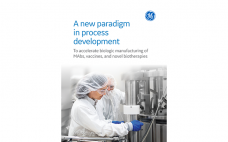Since the 2009 enactment of the Biologics Price Competition and Innovation Act (BPCIA) (1), the US Food and Drug Administration (FDA) has licensed six biosimilar products under PHS 351(k) and approved one product under FD&C 505 (b)(2). It also provided complete response letters (CRLs) to four biologics license application (BLA) filings (Table 1) (2). By comparison, the European Medicines Agency (EMA) has approved 31 biosimilar products (3) and refused or withdrawn about five. There is no doubt that US market…
eBooks
High-Throughput Technologies: Accelerating Process Development
One of the key elements of any biopharmaceutical drug development project is the timeline from identification of the appropriate DNA sequence to investigational new drug (IND) application filing and the start of clinical trials. Typically, this timeline ranges from 18 to 20 months, depending on the type of molecule being developed and the extent and requirements of the chemistry, manufacturing, and controls (CMC) packages supporting the nonclinical and clinical parts of a development program. There is constant pressure to shorten…
U.S. Approval of Three Rapid Microbiological Methods for MACI Product Release
Short time frames are a major challenge in developing alternative microbiological methods for autologous cell therapy products. Ideally, results are made available in under a day. Obtaining regulatory acceptance also can be a challenge, but it is made easier if methods are included in an application (e.g., a biologics license application, BLA) rather than changing a method that is already part of an approved process. Comparing different detection platforms can be a challenge if they have different readouts, and validation…
Comparing Adherent-Cell Technologies: Amplification of Virus Stocks and Viral Vectors
FUJIFILM Diosynth Biotechnology (FDB) is a multifunctional commercial development manufacturing organization (CDMO) that manufactures virus-based therapeutics. Its site in Texas specializes in both adherent and suspension cell culture for production of virus vectors and for development of analytical assays to support production and expression of our clients’ therapeutics. We work with a number of cell lines such as human embryonic kidney (HEK293) and human retinal cells (Johnson & Johnson/Crucell’s proprietary PER.C6 line), which can grow in suspension. However, many of…
eBook: Advances in Single-Use Platforms for Commercial Manufacturing
This special report from Sartorius Stedim Biotech explores recent advances in single-use process platforms for commercial production of biopharmaceuticals. Enormous developments have been made in single-use systems, allowing biomanufacturers to adopt the technology in critical applications within their commercial-scale facilities. The authors illustrate how companies can work with teams of experts from supplier organizations to implement end-to-end single-use bioprocesses at scales up to 2,000 L by carefully considering the approach from the earliest stages in process development. Finally, the report…
Are All Protein A Resins the Same? A Performance Comparison of Eight Different Protein A Resins
Protein A affinity chromatography continues to be the preferred method for commercial purification of antibodies due to its very high selectivity and robust resin performance over repeated purification cycles. It is now estimated that over US$125 billion of yearly sales will be generated from monoclonal antibody (MAb) products by 2020 (1). The clear majority will be purified by large-scale protein A affinity chromatography. With the continued growth and therapeutic commercial importance of MAb production, the availability of high-quality resin material…
eBook Download: A New Paradigm in Process Development
As the need to accelerate biopharmaceutical development around the world continues to grow, biomanufacturers face a host of challenges so they, too, can grow. Increasing process productivity, reducing cost, mitigating risk, and bringing products to market faster are just a few of the issues frequently addressed. But with support in process development, cGMP manufacturing and training, accelerating bioprocess development can become less challenging. Several biomanufacturers have successfully navigated these issues in collaboration with GE Healthcare’s Fast Trak Services. Whether…
Advances in Gene Therapy: MiniTEM™ Represents a Paradigm Shift in the Characterization of Viral Vectors
Gene therapy is one of the most progressing fields in life sciences. Although only eight gene therapy products have reached market approval, the pipeline is robust with ~500 candidates in different stages of clinical development. More than 1,700 clinical studies are being conducted, and the value of this industry segment is expected to grow by ~17% annually over the next 10 years. Gene therapy involves using genetic material to fight or prevent disease. The gene is delivered into a patient’s…
Achieving Consistent Performance by Managing Raw Material Variability Through Predictive Modeling
The past 30 years have brought significant progress in the design and manufacture of cell culture media as well as in the types of components used. With these advances, the biopharmaceutical industry improved its processes — from producing just a few milligrams of product per liter of culture to ≥10 g/L. Since the early days of microbiology, peptones have been used widely as a basic ingredient of microbial media. In the 1990s, peptones were introduced as a substitute for serum…
Collaborate to Innovate: Shaping the Future Pharmaceutical Manufacturing Landscape
As the demand for new life-enhancing therapies increases globally, the pharmaceutical manufacturing community faces an unprecedented challenge to accelerate speed to market. Keeping up to date on industry trends is critical to maintaining a competitive edge. But how do you actively drive these trends and apply them to your manufacturing processes to bring your innovation strategy to life? Whether you are implementing single-use technologies to reduce costs and increase productivity or expanding your operations in emerging markets, scientific collaboration and…









